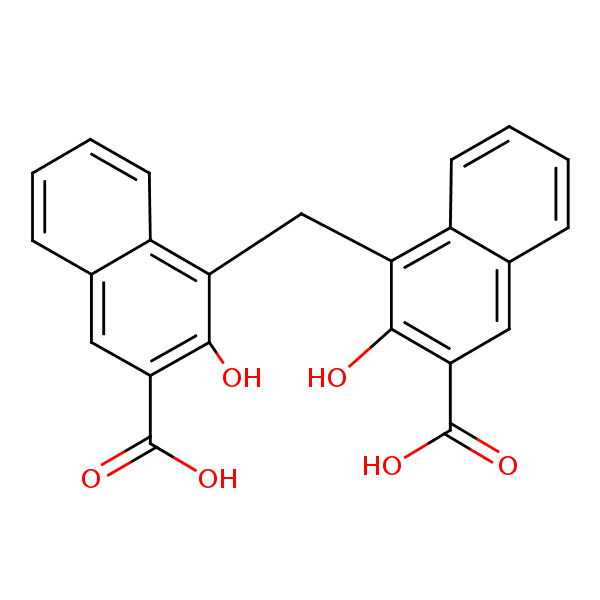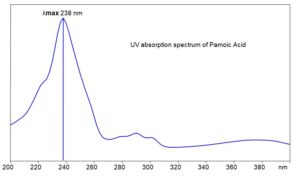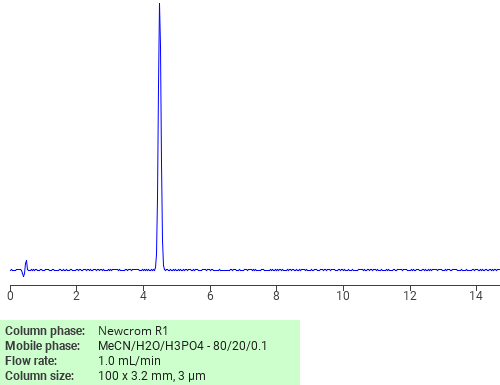| CAS Number | 130-85-8 |
|---|---|
| Molecular Formula | C23H16O6 |
| Molecular Weight | 388.375 |
| InChI Key | WLJNZVDCPSBLRP-UHFFFAOYSA-N |
| LogP | 5.21 |
| Synonyms |
|
Applications:
UV-Vis Spectrum of Pamoic Acid
July 25, 2024
For optimal results in HPLC analysis, it is recommended to measure absorbance at a wavelength that matches the absorption maximum of the compound(s) being analyzed. The UV spectrum shown can assist in selecting an appropriate wavelength for your analysis. Please note that certain mobile phases and buffers may block wavelengths below 230 nm, rendering absorbance measurement at these wavelengths ineffective. If detection below 230 nm is required, it is recommended to use acetonitrile and water as low UV-transparent mobile phases, with phosphoric acid and its salts, sulfuric acid, and TFA as buffers.
For some compounds, the UV-Vis Spectrum is affected by the pH of the mobile phase. The spectra presented here are measured with an acidic mobile phase that has a pH of 3 or lower.

HPLC Method for Analysis of Pamoic Acid on Primesep B Column
February 5, 2024
HPLC Method for Analysis of Pamoic acid on Primesep B by SIELC Technologies
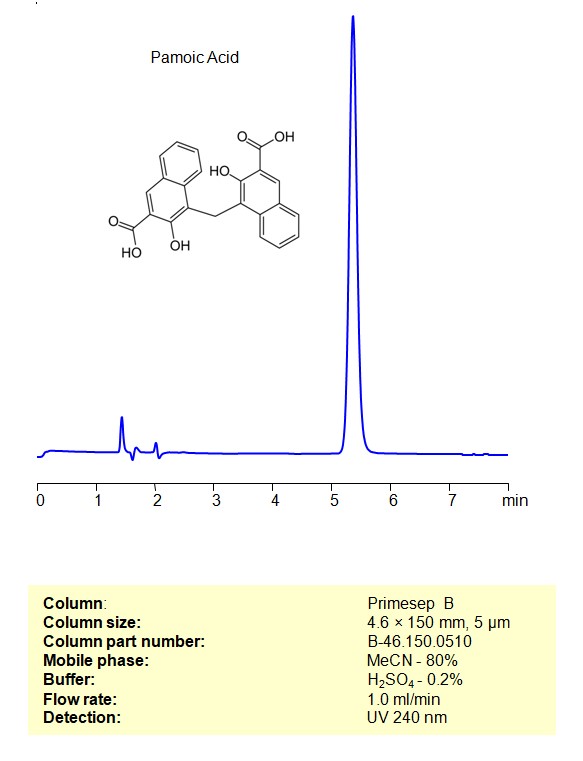
High Performance Liquid Chromatography (HPLC) Method for Analysis of Pamoic acid
Pamoic acid, also known as embonic acid, is a compound used in the formation of salts, particularly pamoate salts. The pamoate salts of various drugs are often employed to enhance their solubility, stability, and overall pharmaceutical properties. Pamoic acid itself is characterized by its ability to form stable complexes with a variety of drugs, and these complexes can be more easily processed into pharmaceutical formulations. The use of pamoic acid and its salts is common in the pharmaceutical industry to improve the bioavailability and effectiveness of certain medications. The formation of pamoate salts is a strategy employed in drug development to optimize the therapeutic delivery and performance of various pharmaceutical compounds.
Pamoic acid can be retained, and analyzed using a Primesep B mixed-mode stationary phase column. The analysis utilizes an isocratic method with a simple mobile phase consisting of water, acetonitrile (MeCN), and sulfuric acid as a buffer. Detection is achieved using UV 235 nm
| Column | Primesep B, 4.6 x 150 mm, 5 µm, 100 A, dual ended |
| Mobile Phase | MeCN/H2O -80% |
| Buffer | H2SO4 – 0.2% |
| Flow Rate | 1.0 ml/min |
| Detection | UV 240 nm |
| Class of Compounds | Acids, Aromatic carboxylic acids |
| Analyzing Compounds | Pamoic acid |
Application Column
Primesep B
Column Diameter: 4.6 mm
Column Length: 150 mm
Particle Size: 5 µm
Pore Size: 100 A
Column options: dual ended

HPLC method for Separation Pamoic Acid, Ivermectin, Pyrantel on Primesep 100 Column
February 2, 2024
High Performance Liquid Chromatography (HPLC) Method for Analysis of Pamoic acid, Ivermectin B1a, Pyrantel on Primesep 100 by SIELC Technologies
Separation type: Liquid Chromatography Mixed-mode SIELC Technologies
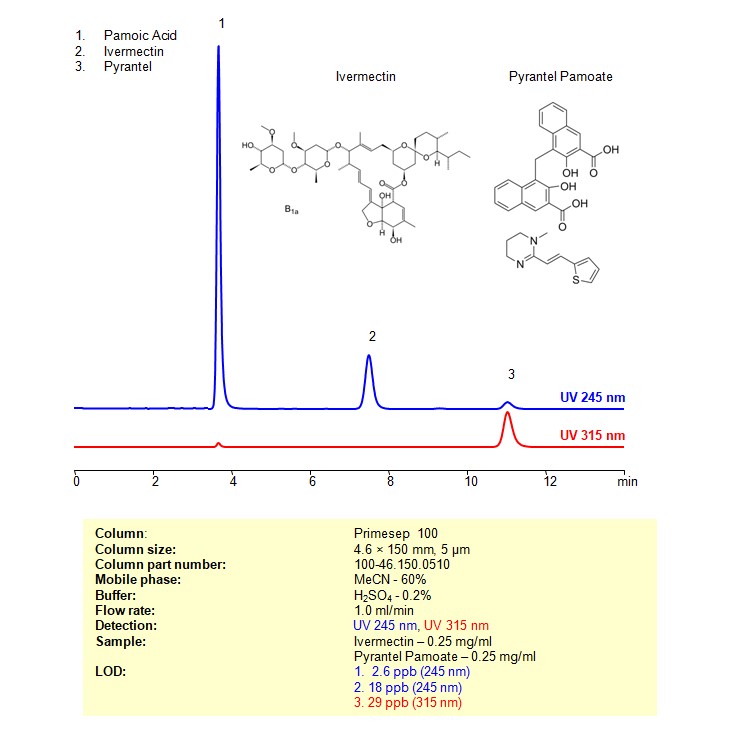
High Performance Liquid Chromatography (HPLC) Method for Analysis of Pamoic acid, Ivermectin B1a, Pyrantel
Pamoic Acid:
- Pamoic acid is a compound used in pharmaceuticals, particularly as a salt form.
- Its salt, such as pamoate salts, is often used to improve the solubility and stability of certain drugs.
- Pamoic acid is commonly used in the formulation of drugs to enhance their pharmacokinetic properties.
Ivermectin:
- Ivermectin is an antiparasitic medication that belongs to the class of drugs called avermectins.
- It is widely used to treat parasitic infections, including certain types of roundworm infections and scabies.
- Ivermectin works by interfering with the nervous system of parasites, leading to their paralysis and eventual death.
Pyrantel:
- Pyrantel is an anthelmintic or deworming medication.
- It is commonly used to treat infections caused by roundworms and hookworms.
- Pyrantel works by causing neuromuscular blockade in the parasites, leading to their expulsion from the digestive tract.
Pamoic Acid, Ivermectin, Pyrantel be retained, separated and analyzed using a Primesep 100 mixed-mode stationary phase column. The analysis employs an isocratic method with a simple mobile phase comprising water, acetonitrile (MeCN), and sulfuric acid as a buffer. This method allows for detection using UV 245 and 315 nm
| Column | Primesep 100, 4.6 x 150 mm, 5 µm, 100 A, dual ended |
| Mobile Phase | MeCN – 60% |
| Buffer | H2SO4 -0.2% |
| Flow Rate | 1.0 ml/min |
| Detection | UV 245, 315 nm |
| Samples | Ivermectin – 0.25 mg/ml Pyrantel Pamoate – 0.25 mg/ml |
| Injection volume | 2 µl |
| LOD* | 1. 2.6 ppb (245 nm) 2. 18 ppb (245 nm) 3. 29 ppb (315 nm) |
| Class of Compounds | Drugs |
| Analyzing Compounds | Pamoic acid, Ivermectin B1a, Pyrantel |
Application Column
Primesep 100
Column Diameter: 4.6 mm
Column Length: 150 mm
Particle Size: 5 µm
Pore Size: 100 A
Column options: dual ended
Pamoic acid
Pyrantel

Separation of Pamoic acid on Newcrom R1 HPLC column
May 16, 2018
Pamoic acid can be analyzed by this reverse phase (RP) HPLC method with simple conditions. The mobile phase contains an acetonitrile (MeCN), water, and phosphoric acid. For Mass-Spec (MS) compatible applications the phosphoric acid needs to be replaced with formic acid. Smaller 3 µm particles columns available for fast UPLC applications. This liquid chromatography method is scalable and can be used for isolation impurities in preparative separation. It also suitable for pharmacokinetics.
Application Column
Newcrom R1
The Newcrom columns are a family of reverse-phase-based columns. Newcrom A, AH, B, and BH are all mixed-mode columns with either positive or negative ion-pairing groups attached to either short (25 Å) or long (100 Å) ligand chains. Newcrom R1 is a special reverse-phase column with low silanol activity.
Select options